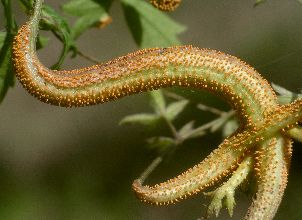
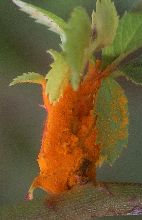
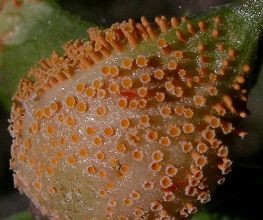
|
F - E - Iron! O - 2 - Oxide! Iron! Oxide! Rust, Rust, RUST! |
Other students' parents probably didn't know what we were shouting about, but we sounded appropriately enthusiastic.
Anyway, the key word here is "rust." I am not, though, talking about a reaction between two elements, but a group of fungi. If you were paying attention as you started reading this, you would have noticed that I mentioned that kingdom in the first paragraph.



The rusts, plant parasites in the family Pucciniaceae, are probably named for the often characteristic color of their spores: orange. If the leaves are affected, then it really does look like they are covered in rust. The most notorious of these infect important crops, especially grains. I learned what little I know about these fungi after finding strange growths on wild plants, including Old Man's Beard (Clematis drummondii), Balloon Vine (Cardiospermum halicacabum) and Prairie Rose (Rosa setigera). These turned out to be fungi in the genus Puccinia. Performing, as I do, in an opera orchestra, I found the name very easy to remember. For those readers who are not familiar with operas, one of the most famous composers of these is Puccini. As you can see from the photos, the spores are brilliant orange and so are very easy to notice. The fungus also causes swelling of the stems in these three plants, all of which happen to be vines, sometimes creating strange distortions that look more like sculptures than plants.
What I think is particularly interesting, though, is the shape of the spore tubes, or the openings through which the fungal spores disperse. Each short tube bursts at the tip, looking very much like an exploded joke cigar. The tubes tend to be arranged equal distance from each other and so form a pattern on the plant's surface. The spore tubes are so small that they are hard to appreciate without magnification. Luckily, a digital camera is all that one needs to get a better look.
If the fungi in the genus Puccinia are intriguing, they are nothing compared to Cedar Apple Rust (Gymnosporangium juniperivirginianae). I remember finding strange orange growths on evergreen trees in Illinois when I was a kid. They looked something like weird little jellyfish and sometimes appeared after a good rain. I only knew that they were some sort of fungus but had no more information on them. Well, I've now learned, decades later, that they were another species of Gymnoporangium.
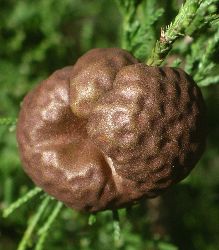
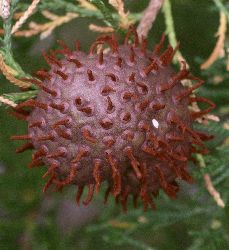
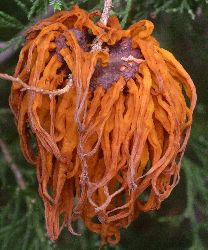
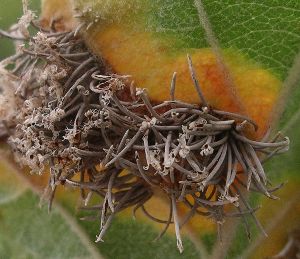 So back to the Cedar Apple Rust here in Texas. I first saw odd galls on some Red Cedar (Juniperus virginiana) at the Lady Bird Johnson Wildflower Center. They were very woody and dimpled. This is the form that the fungus takes during the winter. Later, in the spring, the galls produced little bumps out of the dimples. Then, after some good rains, the whole glob was covered with gooey orange strands. The spores had been released into the wind.
So back to the Cedar Apple Rust here in Texas. I first saw odd galls on some Red Cedar (Juniperus virginiana) at the Lady Bird Johnson Wildflower Center. They were very woody and dimpled. This is the form that the fungus takes during the winter. Later, in the spring, the galls produced little bumps out of the dimples. Then, after some good rains, the whole glob was covered with gooey orange strands. The spores had been released into the wind.
The story doesn't end there. As the name implies, Cedar Apple Rust does not just grow on Red Cedar. In fact, it cannot survive without its other host, apple trees in the genus Malus. The spores produced from the galls on the Red Cedar have to infect a completely different plant. In the case of this particular infestation, the other host turned out to be a Blanco Crabapple (Malus ioensis). I'd forgotten all about galls on the Cedar when I noticed some yellowish-orange spots on the leaves of a Crabapple tree in the same vicinity. A close look revealed the odd spore tubes with the exploded ends, and all the information fit together. A quick search of the Red Cedar showed that there were, indeed, tiny galls starting to form already. The spores from the Crabapple had found their target and the Rust's lifecycle had come full circle.